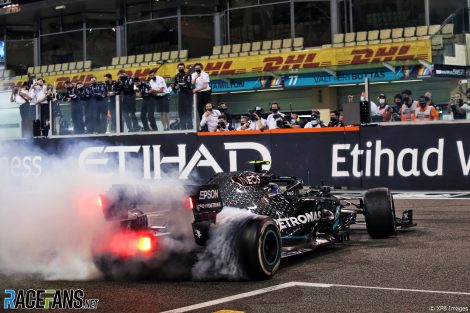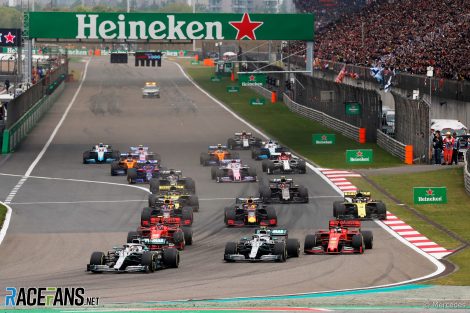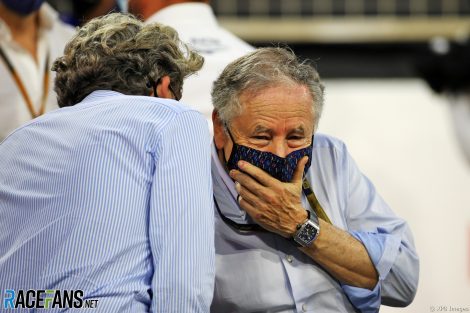Although 2020 will in many ways go down in Formula 1 history as an annus horribilis – albeit thankfully without the tragedies that blighted some seasons – the year just past illustrated that the sport can deal decisively and efficiently with adverse conditions. F1 can arguably hold its head higher than other elite sports following its reaction to the challenges posed by Covid-19, not only with regard to the robustness of its testing regime, but also the extraordinarily low number of infections amongst F1 personnel.
One infection is, of course, one too many. But the fact is F1 regularly moved 2,000 people across borders on no fewer than a dozen occasions, with each trip multiplying the risk of infection, particularly towards the end of the season where spectators were permitted. Yet the number of on-site ‘positives’ averaged well under 10 per week, which was remarkable.It would be naïve to believe Covid respects calendars more than it respects borders. It was inevitable the pandemic would continue into 2021, and various countries are again in stringent lockdowns.
Last weekend we broke the news that the Australian Grand Prix is likely to be postponed. An official announcement is expected shortly, but the crucial word here is ‘postponed’.

As though that were not enough, F1 teams face probably the most challenging season on record. Not only will they need to grapple with uncertain logistics but be forced to gear up for 2022, which brings the most sweeping technical changes in recent history, all while wrestling with the effects of budget caps and revised prize money structures.
There are big changes at the very top of the sport as well. The 2021 season marks the end of the FIA’s four-yearly presidential election cycle and the last of Jean Todt’s three mandates. Meanwhile Stefano Domenicali moves into the Liberty hot seat as replacement for Chase Carey. Clearly, potential for disruption exists.
Advert | Become a RaceFans supporter and
Last year folk queried F1’s optimism when it launched its reconfigured, 17-race calendar in response to the pandemic. Former F1 chief Bernie Ecclestone and ex-FIA president Max Mosley even called for the season to be cancelled entirely. Yet Liberty pulled off its fixtures. More recently others made similar claims of irresponsibility when Liberty revealed a 23-race 2021 F1 calendar, but it would surely have been utterly irresponsible to have planned not to race.

F1 itself is indebted to stakeholders: Circuits had contracts cancelled at short notice; teams across the grid earned less; fans did not enjoy the full spectacle – fewer rounds were staged, plus they were excluded from all bar a few (reduced capacity) races – and broadcasters and advertisers did not receive full value. No blame laid at Liberty’s feet, but the fact is strenuous efforts are required to maintain faith and trust. Hence 23 races.
However it is likely the early part of the season will be rearranged, with events slipping down the order or replaced entirely by grands prix in more Covid-friendly territories, primarily in Europe where turnarounds can be quicker. Don’t be surprised if one of 2020’s substitute races replaces China’s round should the country get iffy about admitting foreigners, as is now strongly rumoured will be the case for the grand prix. Another European event is expected to slot into the TBC date created by Vietnam’s dallying.

Due to the ravaging effects of Covid, the FIA delayed introduction of F1’s ‘new era’ regulations by a year to 2022, concurrently imposing freezes on design and development until exactly a year ahead of introduction, i.e. January 1st 2021. You can bet your last coin that all teams were geared up to start work on their 2022 challengers as the clock struck midnight.
The 2022 regulations are expected to be ‘clarified’ considerably as and when ambiguities and unintended consequences are identified. Accordingly, teams are likely to be circumspect about investing resources in ‘grey’ areas, particularly as such activities are now subject to budget cap restrictions and aerodynamic test regulations. F1’s days of open-end spending are over.
Advert | Become a RaceFans supporter and
These budget cap restrictions apply mainly to major teams, and they have unenviable issues to contend with: downsizing staffing levels and resources to meet 2021’s budget cap of $145 million (£106m). McLaren is believed to have completed its retrenchment process, but Mercedes, Ferrari and Red Bull are still restructuring departments and transferring staff to advanced (non-F1) engineering divisions.

However, with budget caps reducing by a further $5m to $140 for 2022 (and to $135 for 2023), teams need to formulate further retrenchment plans. Carrying over of (large) chunks of last year’s cars for the stopgap 2021 season potentially makes life easier, but car development has not been totally banned, and the year-to-year changes are more extensive than perhaps anticipated.
The partial development ‘freeze’ was formulated with the best of intentions, namely reducing costs and effort during the transitional year. But then – as always in F1, which tends to make last-minute, invariably compromised changes – unintended consequences reared their collective heads once the changes had been agreed.
In order to control development costs a token system was formulated with parts given a one or double token value to enable teams to select which areas of the cars they could upgrade. However, whether by intention or design, non-listed parts sourced from another team may be upgraded for free to their 2020 specification as the supplying teams carry the ‘cost’.
Thus, the likes of Racing Point (Aston Martin this year), Haas and AlphaTauri potentially stand to gain from upgrades ‘paid’ for by their supplying teams, namely Mercedes, Ferrari and Red Bull respectively. McLaren, which switches to Mercedes power unit from Renault via a pre-agreed contract intended for the 2022 regulations but sources no further parts from the Three-Pointed Star, will expend its token allocation on the engine change.

Also pencilled into 2021’s agenda are talks about F1’s future power units – a crucial topic given increasing global opposition to fossil-fuelled internal combustion engines. On one hand F1 needs to embrace zero-carbon fuels to remain relevant; on the other it needs to attract additional engine suppliers as safeguard against exits by existing manufacturers, any of whom could walk within a year, as Honda will in less than 12 months’ time.
This is where it gets political: Existing suppliers prefer as little as competition as possible given that additional brands dilute the kudos of competing in F1, while their presence potentially reduces demand on individual suppliers, in turn affecting the marginal costs of engine production. Yet the suppliers need to absorb the extra costs as engine prices are capped.
Engine suppliers, who usually push for delays in regulation changes, are calling for truncated timeframes for alternate fuel engine regulations but disguising their concerns by citing environmental grounds. The shorter the development runway, the less chance of any new engine suppliers appearing. Mercedes’ biggest nightmare is arguably Porsche, while Renault’s is a resurgent Peugeot.
Another engine battleground is the still unresolved question of whose power units Red Bull and AlphaTauri will after Honda leave. The first prize for them is to persuade the FIA, F1 and all teams to accept an engine freeze from 2022 until the end of the current formula (the window being 2025/6 but still open) to enable both teams to continue with Honda power units, if they are bequeathed by the Japanese company upon its exit.

Another option is for Ferrari, which has capacity for a single further team, to voluntarily supply, say, AlphaTauri. In this scenario the FIA would be forced to call upon Renault to supply Red Bull under nomination regulations that kick in when a team is stranded – the supplier with the fewest customers is nominated to plug the gap. In a stroke the Red Bull teams’ synergies and interdependence with major components would be struck a severe blow.
Finally, 2021 marks the year of big changes at the top of the FIA and F1. After Todt was elected in 2009 he ordered an overhaul of the governing body’s statutes, with limits imposed on office terms (three) and age (75 years) at time of election. Todt was elected thrice (2009, ’13 and ’17) and turns 75 next month. Thus, the FIA’s General Assembly in December will feature presidential elections.
Who will succeed Todt? Candidates are unlikely to show their hands before July, but runners include: FIA Sport deputy-president Graham Stoker, a barrister specialising in sports and international law; Mohammed bin Sulayem, Emirati rally champion, president of the UAE Automobile & Touring Club and FIA official; and world rally champion and motorsport entrepreneur David Richards CBE, chairman of Motorsport UK.

All in, an exceptionally challenging year awaits F1, and not only due to Covid – whose unpredictability is likely to tax the sport’s masters at least as much as in 2020, if not even more so in light of the scale of F1’s ambitions for 2021.
The nation-wide lockdown imposed by British prime minister Boris Johnson this week against the backdrop of a soaring infection rate despite the roll-out of a vaccination programme proved just how quickly things can change. The largely unknown effects of Brexit add further uncertainty in the country which is home to a majority of F1’s teams.
F1 and its competitors collectively managed to weather last year with aplomb, emerging all the stronger for the experience, and the same can be expected this year. But, as the foregoing outlines, it surely won’t be plain sailing.
Join the RaceFans Supporters Drive!
 If you've enjoyed RaceFans' motor sport coverage during 2020, please take a moment to find out more about our Supporter Drive.
If you've enjoyed RaceFans' motor sport coverage during 2020, please take a moment to find out more about our Supporter Drive.
We're aiming to welcome 3,000 new Supporters to help fund RaceFans so we can continue to produce quality, original, independent motorsport coverage. Here's what we're asking for and why - and how you can sign up:
RacingLines
- The year of sprints, ‘the show’ – and rising stock: A political review of the 2021 F1 season
- The problems of perception the FIA must address after the Abu Dhabi row
- Why the budget cap could be F1’s next battleground between Mercedes and Red Bull
- Todt defied expectations as president – now he plans to “disappear” from FIA
- Sir Frank Williams: A personal appreciation of a true racer





Patrick (@paeschli)
6th January 2021, 12:50
What’s stopping F1 from starting with a Bahrein double-header? The alternative track lay-out was well received (by fans).
Jere (@jerejj)
6th January 2021, 13:19
@paeschli Doing two races in the same place (a la Red Bull Ring, Silverstone, and Bahrain) would probably only be a last resort thing if getting at least 15 races (for TV broadcasting reasons) was difficult to achieve otherwise. Too early for such measures at this point.
H67
6th January 2021, 13:13
I’m absolutely fine with 2021 becoming another version of 2020. People understand it’s still to dangerous to hold to the kind of schedule F1 wanted. So scramble it up and race where possible.
The new normal of 2022 may present the all new car and the F1 calendar and it’s series we all hope for.
Jere (@jerejj)
6th January 2021, 13:24
So the Chinese round could be under threat as well, even though I’ve been relatively hopeful of it happening this whole time. Time will tell.
Should F1 somehow manage to reschedule Australia, it’d, in the case, have to become a fixture late-season event as otherwise, the gap between the 2020 race and the 2021 race would be unnecessarily small considering the dismantling and build-up processes. I doubt the temporary infrastructures could be kept in place throughout the period from November to March. Or from October to March.
RP (@slotopen)
6th January 2021, 13:39
What impact is the lockdown having on british-based teams?
Will this put teams-based outside of Britain at a development advantage?
Jere (@jerejj)
6th January 2021, 13:52
@slotopen I don’t think so, although the lockdown might have an impact on travelling from the UK to elsewhere. In this case, no race could take place as races would be viable with only Ferrari, Alpha Tauri, and Alfa Romeo participating. I’m not this pessimistic, though. Definitely not at this point.
Robert McKay
6th January 2021, 14:15
The problem with the 23 race calendar is largely that it’s much harder to rearrange “postponed” races because there’s no obvious available slack in the system to do that.
You’re only going to need two or three early season “postponements” before they effectively start to become cancellations, unless Liberty are holding back a newly-invented calendar month for this year.
I think the calendar will be less disrupted than last season but it’s still going to have some disruption in there I reckon, unless they’ve got a decent number of circuits happy to be shifted in the calendar at relatively short notice.
Jere (@jerejj)
6th January 2021, 16:43
@Robert McKay, I share these views with you.
Kribana (@krichelle)
6th January 2021, 16:36
I guess we will have almost no chance to watch races live on track… *Sigh* was hoping to get one last view of the fastest cars in history… At least I watched and I got videos of the cars tackling the s section at Suzuka in 2019.
Jere (@jerejj)
6th January 2021, 16:43
@krichelle Maybe later in the year, trackside attendance becomes viable, if not early into the season. Not only Melbourne, but Monaco, Baku, and Singapore also need spectator attendance, as does Jeddah.
Kribana (@krichelle)
6th January 2021, 17:01
Yea… ironically most of the races you mentioned are the most expensive ones on the calendar lol. I don’t think I can afford Monaco or Singapore. Maybe Zandvoort in the Netherlands on October if this pandemic could tone down a bit. Let’s just wait and see. Initial signs though do not look good for people wanting to watch live on track.
ruliemaulana (@ruliemaulana)
6th January 2021, 18:03
@dieterrencken Was there’s no plan from to inoculate 2,000 person before pre-season test? I don’t think that’s an impossible task for organization as big as F1.
Mauro (@)
6th January 2021, 21:20
Come on everybody. With all the Covid shaite, and everybody need to stay home, more races, the better. I’d loved last year having races in December. It makes all the sense also in terms of broadcasting. They’ll make tons of money. I am sure the cable television audience grew last year!
Mauro (@)
6th January 2021, 21:23
They need to allow sponsorship from cigarretes, e-cigs, beer, sox, drugs and rock’n’roll….Bring in the money, since money talks and BS walks
@HoHum (@hohum)
6th January 2021, 23:20
Domenicali is “calm and considered” !? I thought he was Italian.